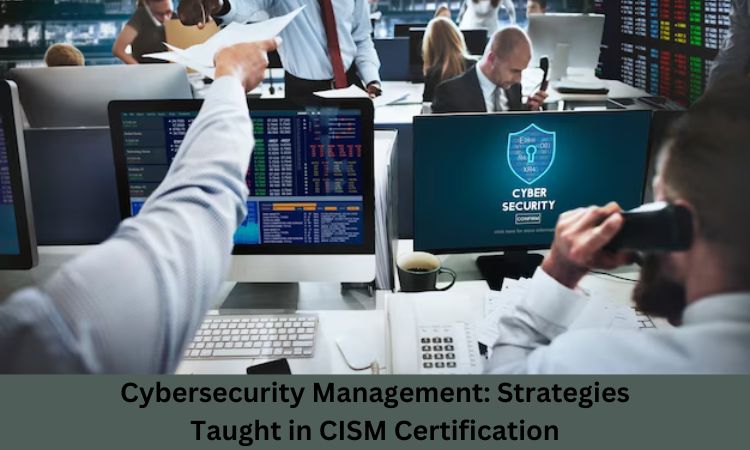- Establishing and Managing the Information Security Program
One of the core areas covered in the CISM certification is the establishment and management of an information security program. This involves several key steps:
1.1 Understanding Organizational Objectives
The first step is to understand the organization’s mission, goals, and objectives. This understanding helps in aligning the information security program with the organization’s business objectives.
It ensures that the security measures put in place support the organization’s operations and growth.
1.2 Developing Security Policies and Procedures
Developing comprehensive security policies and procedures is crucial. These policies outline the rules and guidelines for employees to follow to protect sensitive information.
Procedures provide step-by-step instructions on how to implement these policies effectively.
1.3 Risk Assessment and Management
Conducting regular risk assessments to identify potential threats and vulnerabilities is essential.
- Risk management involves evaluating the identified risks and implementing appropriate measures to mitigate them.
1.4 Continuous Monitoring and Improvement
- An effective information security program requires continuous monitoring to detect and respond to security incidents promptly.
- Regular audits and assessments help in identifying areas for improvement and ensuring compliance with security policies.
2.Information Risk Management and Compliance
Risk management is a critical component of cybersecurity management. The CISM certification emphasizes the importance of identifying, assessing, and managing information security risks.
2.1 Identifying Information Assets and Risks
- Identifying all the information assets within the organization, such as data, hardware, and software, is the first step.
- Understanding the value of these assets and the potential risks associated with them helps in prioritizing security efforts.
2.2 Risk Analysis and Assessment
- Risk analysis involves evaluating the likelihood and impact of potential threats to information assets.
- This assessment helps in determining the level of risk and the appropriate measures to mitigate it.
2.3 Developing Risk Mitigation Strategies
- Based on the risk assessment, developing strategies to mitigate identified risks is crucial.
- This may include implementing security controls, such as firewalls, encryption, and access controls, to protect sensitive information.
2.4 Ensuring Compliance with Regulations
- Compliance with legal and regulatory requirements is an important aspect of risk management.
- The CISM certification teaches professionals how to stay updated with the latest regulations and ensure that their organization complies with them.
- Incident Management and Response
Effective incident management and response are essential to minimize the impact of security breaches and ensure a swift recovery.
3.1 Post-Incident Review
- After an incident has been resolved, conducting a post-incident review helps in identifying lessons learned and improving the incident response plan.
- This review helps in strengthening the organization’s security posture and preventing similar incidents in the future.
3.2 Incident Detection and Analysis
- Early detection of security incidents is crucial to prevent further damage.
- Analyzing the incident helps in understanding the cause and impact, which is essential for effective response and prevention of future incidents.
3.3 Containment, Eradication, and Recovery
- Containment involves isolating the affected systems to prevent the spread of the incident.
- Eradication focuses on removing the cause of the incident and restoring the affected systems to normal operation.
- Recovery includes restoring data and services to ensure business continuity.
- Information Security Governance
Information security governance involves establishing and maintaining a framework to manage information security effectively.
4.1 Establishing a Governance Framework
- A governance framework defines the structure, roles, and responsibilities for managing information security within the organization.
- It ensures that there is clear accountability and oversight for security activities.
4.2 Defining Security Objectives and Metrics
- Defining clear security objectives helps in measuring the effectiveness of the information security program.
- Metrics are used to track progress and identify areas for improvement.
4.3 Implementing Security Controls
- Implementing appropriate security controls, such as access controls, encryption, and monitoring systems, is crucial to protect information assets.
- These controls help in preventing unauthorized access and ensuring the integrity and confidentiality of data.
4.4 Ensuring Continuous Improvement
Continuous improvement is essential to keep up with evolving security threats.
- Regular reviews and updates to the security program help in maintaining its effectiveness.
- Information Security Program Development and Management
Developing and managing an information security program involves several key activities.
5.1 Developing a Security Strategy
- A security strategy outlines the long-term goals and objectives for the information security program.
- It provides a roadmap for implementing security measures and achieving the desired security posture.
5.2 Resource Management
- Effective resource management ensures that the information security program has the necessary resources, such as budget, personnel, and technology, to achieve its objectives.
- Allocating resources based on risk priorities helps in optimizing the use of available resources.
5.3 Training and Awareness
- Training and awareness programs are essential to educate employees about security policies, procedures, and best practices.
- Regular training helps in ensuring that employees understand their roles and responsibilities in protecting sensitive information.
5.4 Collaboration and Communication
Collaboration and communication with stakeholders, such as senior management, IT teams, and external partners, are crucial for the success of the information security program.
- Regular communication helps in ensuring that everyone is aware of security initiatives and their role in supporting them.
The CISM certification provides professionals with the knowledge and skills required to manage and govern an organization’s information security program effectively. The strategies taught in the certification cover various aspects of cybersecurity management, including establishing and managing the information security program, risk management, incident response, security governance, and program development. By implementing these strategies, professionals can help their organizations protect sensitive information, mitigate risks, and ensure business continuity in the face of evolving cyber threats.

